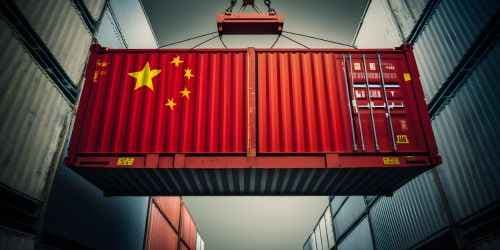
Revolutionizing China’s Economy Bold Moves You Can’t Ignore
 ACY Securities - Luca Santos
ACY Securities - Luca Santos
Starting the year on a tough note, China's stock markets have finally picked up pace, showing that the People's Bank of China (PBoC) is serious about boosting confidence. While the expected 50 basis points cut in the required-reserve ratio (RRR) was as predicted, the fact that it happened during a live press conference where Governor Pan explained a comprehensive support package (different from the usual release) shows a keen awareness of the current situation.
With extra measures for money and support for credit, plus plans to stabilize financial situations in real estate, “we expect the markets to follow the stabilization story at least until the Lunar New Year. However, the decisions and reports this week raise more questions than they answer.” – Says Geoff Yu, EMEA MACRO STRATEGIST from BNY Mellon.
If Beijing wants a fundamental reassessment of investment into China, this week's decisions, if fully put into action, are just the beginning. Structural changes, still necessary, are beyond the PBoC's job. People are looking to the National People's Congress (starting on March 5) for the next steps.
As explained on my 2024 Outlook, a significant theme for the year is more money coming into China than expected. Foreign investors haven't put in as much as they could. A local reason for pricing is essential, and whether it comes from real changes, or a regular buying program doesn't matter. If a big buyer appears, both those who manage money passively and actively will need to change things to stay close to their usual standards.
Beijing seems to be going for a buying program, and now people are looking closely at how big it will be. The surprising part is that instead of using the PBoC's technically unlimited money for buying things, reports say authorities are more focused on using "offshore accounts of Chinese state-owned businesses" to buy things in Hong Kong. In theory, this could help the renminbi by buying things with offshore money that has a lot of foreign exchange.
Northbound Flows & Quota Balance

Source: Macrobond, BNY Mellon
The first thing to think about is how big it will be. The reported CNY 3 trillion in total buying is a lot, around 4-6% of the combined market size of Shanghai and Shenzhen. For now, the quotas seem enough for a six-week buying program, but there might be a need for more programs to keep stock prices up, and people might see future parts of the program in different ways.
There are also questions about where the money comes from. Some people are worried that the PBoC will need to help offshore money with selling things it has. However, we think these worries are too big. We also don't think the PBoC will help a lot with getting money. In recent times, China's money growth has not gone up as much as the statistical increase in foreign exchange, especially through the current account. As US dollar profits have gone up on a normal and bigger scale, companies may have wanted to keep more money in US dollars. Overseas parts of Chinese banks also have money through moving it between branches, as shown in statistics from the Bank for International Settlements.
Balance of Payments vs. FX Purchase Positions

Source: Macrobond, BNY Mellon
China's balance of payments has mostly been positive, even though it's been less steady than before. But we can see that the amount of foreign exchange, which is a thing on the PBoC's record that should show changes in dollar money coming in, has been not steady. The changes seen in recent years suggest money moving out in ways not linked to the balance of payments. This buying program can be paid for by China's current money or using money from selling things onshore, but there might not be a lot of room for mistakes.
Even if there are a few dollars to sell, the renminbi should technically get some help. PBoC Governor Pan said during his press conference that China will have more money space to do things if and when the Federal Reserve starts to cut interest rates. If the rate link is still strong for USD/CNY, then there should be more downside risk to the currency pair.
But we're not sure if this is good for an economy still having trouble with prices. Prices were negative in 2023, and China may have only hit its real economic growth goal because of a negative measure, not a good way to grow an economy. Plus, the PBoC, like many other central banks in the area, wants to avoid Japan's experience of prices going down over the last few decades. They're also careful about letting the currency get too strong when the economy isn't doing well.
USDCNY vs. 2y Rate Spread

Source: Macrobond, BNY Mellon
Looking at the net money going into China's stocks from clients in other countries, it's at the lowest in many years. This is a good place to start a recovery. Statements from the State Council down to the PBoC show a clear desire for money to return to China and change how things are invested. The want is there, but what we've seen this week is just the start of trying to make the market and confidence more stable. The limits are also easy to see.
iFlow On China Equities

Source: Macrobond, BNY Mellon
Insights Inspired by BNY Mellon: Credit to Their Analysis for Shaping Some Aspects of This Text
This content may have been written by a third party. ACY makes no representation or warranty and assumes no liability as to the accuracy or completeness of the information provided, nor any loss arising from any investment based on a recommendation, forecast or other information supplied by any third-party. This content is information only, and does not constitute financial, investment or other advice on which you can rely.
LiquidityFinder
LiquidityFinder was created to take the friction out of the process of sourcing Business to Business (B2B) liquidity; to become the central reference point for liquidity in OTC electronic markets, and the means to access them. Our mission is to provide streamlined modern solutions and share valuable insight and knowledge that benefit our users.
If you would like to contribute to our website or wish to contact us, please click here or you can email us directly at press@liquidityfinder.com.
